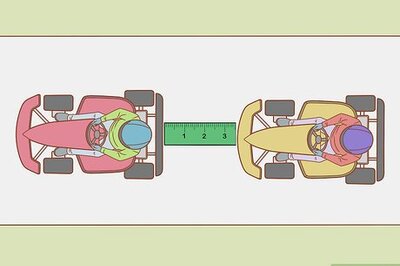
views
New Delhi: Delhi's air quality was recorded in the "poor" category on Thursday as the share of stubble burning in the city's pollution increased to 20 per cent. Government agencies said the air quality may dip to the "very poor" category on Friday and improve slightly on Saturday due to favourable surface wind speed. Delhi's 24-hour average air quality index was recorded at 283.It was 211 on Wednesday and 171 on Tuesday.
An AQI between zero and 50 is considered "good", 51 and 100 "satisfactory", 101 and 200 "moderate", 201 and 300 "poor", 301 and 400 "very poor", and 401 and 500 "severe". According to the Ministry of Earth Sciences' air quality monitor, SAFAR, stubble burning accounted for 20 per cent of Delhi's PM2.5 pollution on Thursday. It was 8 per cent on Wednesday and 3 per cent on Tuesday.
A total of 967 fire fires were observed in Punjab, Haryana and western Pakistan on Thursday, it said. The central government's Air Quality Early Warning System for Delhi also said Delhi-NCR's air quality is likely to remain in the "poor" to the lower end of the "very poor" category on Friday.
SAFAR also said the conductive meteorological environment created after rainfall is slowly retreating and a deterioration in the air quality is likely. The minimum temperature settled at 9.4 degrees Celsius on Thursday – the lowest this season so far – and the maximum wind speed was predicted to be 10 kmph, according to the India Meteorological Department.
Calm winds and low temperatures trap pollutants close to the ground, while favourable wind speed helps in their dispersion. Delhi's ventilation index -a product of mixing depth and average wind speed- was around 7,000 m2/s on Thursday and is likely to be 12,000 m2/s on Friday.
Mixing depth is the vertical height in which pollutants are suspended in the air. It reduces on cold days with calm wind speed. A ventilation index lower than 6,000 sqm/second, with the average wind speed less than 10 kmph, is unfavourable for dispersal of pollutants.
The IMD had earlier said the minimum temperature in Delhi will drop to 9 degrees Celsius by Saturday, as cold winds have started blowing from hilly regions, which have witnessed a fresh bout of snowfall. The minimum temperature this month, barring on November 16, has remained 2-3 degree Celsius below normal in the absence of a cloud cover, according to IMD officials.
Read all the Latest News, Breaking News and Coronavirus News here




















Comments
0 comment